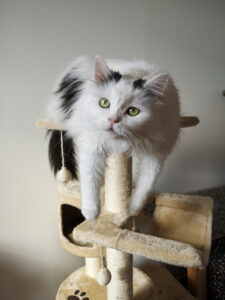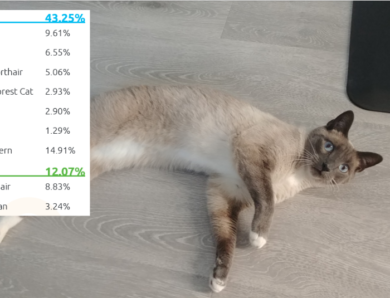
How to Stop Boredom in Cats
The popular notion that cats are lazy and sleep all day is a complete fiction. Cats need much more than a spot to curl up in the sun, a dish of food, and someone to scoop their litter for them. (Though they certainly do enjoy all three.) Happy cats don’t sleep 23 hours a day. Cats that spend all day sleeping are most like bored and depressed.
And that’s not a situation any cat parent wants to be in.
“Cats aren’t completely domesticated,” Dr. Laura Cochrane, co-owner of RoarCats.com, an online cat boutique and former veterinarian says. “We forget that they have needs that are part of their DNA.”
Cat parents who ignore those needs wind up with unhappy cats, many of whom end up with health and behavioral problems that could easily have been prevented.
Keeping It Pawsome spoke with Dr. Cochrane and her partner (in business and life), Jen Krause to discuss dangers of boredom in cats and what kitty parents can do to prevent it.
Find out more about how Dr. Cochrane has been improving the lives of cats, one cat at a time for many years.
What causes boredom in cats?
Boredom in house cats is caused by a lack of enrichment in their environment. Like all animals, cats need stimulation — for their mind and their senses. No stimulation leads to boredom, and ultimately, unhappiness.
Put another way, when a cat’s basic needs to see, hear, smell, and taste the world around him is denied, he’s going to get bored.
Imagine yourself, living in a four-by-four environment with no view of the outside world, no fresh air coming in through a screened-in window or door, and never hearing the sounds of the breeze or the birds. You’d probably go stir-crazy.
Same is true for your cats, even if they were born indoors and have never been outside. Instinctively, they know they’re missing something — and they do miss it!
Need another example? Cats are hard-wired to hunt. It’s why they chase sunlight that reflects off the back of your phone or tackle your ankles as you walk. They can’t help it. The best thing you can do is offer them opportunities to indulge themselves. No, we’re not advocating letting a mouse loose in the house, but you can simulate hunting through a variety of play options.
How do you recognize a bored indoor cat?
Cats are consummate pretenders. It can be very difficult to know when a cat is feeling sick, or injured, or bored. But there are a few key behaviors that can be indicators that your kitty is feeling apathetic.
Too much sleeping is the number one sign. Which, of course, doesn’t necessarily help, because cats do like to sleep a lot and older cats will often sleep even more. But if your kitty is sleeping more than 20 hours a day, something’s probably up — especially for a younger cat!
A cat sleeping that much has basically given up on life. Other signs can be a drop in appetite and over-grooming.
And while it may seem counterintuitive, the lack of stimulation actually results in excess stress on your cat’s physical health.
“People will laugh if you mention chronic stress in cats,” Dr. Cochrane says. “But over time, the boredom, the lack of enrichment, it leads to chronic stress.”
Going away for a week? Here are the most important questions you should ask before hiring a cat sitter.
Why is boredom dangerous for my cat?
Behavioral problems like over-grooming are often a reaction to stress in cats. So is going to the bathroom outside of the litter box, excessive furniture scratching, and frequent — and painful — attacks on your ankles.
The underlying stress causing these behaviors also takes a physical toll on cats. Long periods of unrelieved boredom (aka stress) frequently result in various inflammations, including digestive, cystitis (inflammation of the bladder), and UTIs (urinary tract infection).
Can a cat die of boredom?
Not specifically, no. But chronic stress and related physical illnesses can take a toll on your cat and shorten his life.
And, of course, for the bulk of the time he is alive, he’ll be unhappy. Do you really want that for your fur baby?
How do I prevent my cat from getting bored?
There are a number of ways to keep your cats stimulated, some of which are super simple and require virtually no effort on your part. Nor do you have to spend a fortune.
Open your shades.
The easiest thing you can possibly do for your cat is open the shades, giving your cat a view of the outside world. Krause, who works as a cat sitter in Portland, Oregon, told Keeping It Pawsome she’s shocked at how many homes she visits where the shades are never opened.
Cats crave a view of the outside as much as we do, and cabin fever is just as real a phenomenon in the animal world as it is for humans. Seeing birds, insects, squirrels, and even blowing leaves is stimulation they enjoy. And what cat parent doesn’t love hearing their cats chatter when they see birds?!
Nice day out? Open the window (with a screen in place) and let your cats feel the breeze, hear bird chirping, and smell the outdoor smells.
If you’re able to, you might want to consider adding a bird feeder in your front or backyard. Cat TV, Krause calls it. Apartment dwellers can look for special bird feeders, designed specifically for apartment windows.
Provide vertical spaces.

While a window with a view is the most basic stimulus you can provide you cat, it doesn’t do much good if the cat can’t actually reach high enough to take advantage.
If you can afford it, a cat tree is one of the best investments you can make to ensure you cat’s happiness. Cats enjoy vertical spaces, they can be positioned near windows, and, if you have a dog or a small child in the house, it gives your cat an escape route.
Cats can also benefit from the carpet and/or sisal that is used on cat trees, as they give your kitty a place to safely scratch-and-stretch, a behavior essential to their muscle health.
In multi-cat households, larger cat trees give the cats several places to hang out, and younger cats will have a blast chasing each other around the different levels.
If you don’t want a large cat tree, other options can include wall-mounted cat shelves, under-window perches, and even just putting a small table, chair or the couch near the window so you cat can see outside.
Bring the outside in.
Has your cat every gotten outside by accident? Did she go straight to the grass and start chewing? Another natural and instinctive behavior for cats, you can easily replicate this by providing cat grass from time to time. Most pet stores sell small plants that will last a few days. Even if your cats just sniff it, it’ll be something new and different to get their senses excited.
An easy outside “toy” is a pine cone. If you live in an area with evergreens, grab a pine cone and give it to your cats. The unique texture and smell will pique their interest and keep them occupied for some time.
Play as stimulus.
Cats need play in order to satisfy their natural need to hunt. The easiest option is to leave out a variety of toys your cats can bat and chase around when they want to. But cat parents should also try to dedicate 10 to 15 minutes, twice a day to interactive play using something like a wand, to give their kitties the most stimulation.
Change it up.
Variety is the spice of life, as much for animals as for people. Make sure you rotate toys into and out play on a regular basis. If you leave the same toys out for too long, you cat will get bored of them — unless your cat has a particular favorite that never goes out of favor.
Similarly, if you leave a box out for your cat(s) to play with, change it up every once in a while. If you don’t want to change the actual box, try putting tissue paper or packing paper inside the box. The addition of something as simple as crinkly paper can make the old box an entirely new and exciting experience for your cat.
Learn more about how to play with your cat.
Do what you can.
Not everyone is going to have 10 to 15 minutes, twice a day to play with their cats. Maybe you can only find 15 minutes twice a week. That’s ok. If the rest of the week you’ve left toys out, the blinds up and put out a new box for the cat to jump in and out of, you’re way ahead of the game.
“We all have to work to pay for their food,” Krause says. “We can’t be playing with wand toys with our cats all day long.”
1 Comment
Comments are closed.






Thanks for this article. We have 9 indoor cats and I worry about their health all the time. Thankfully they keep each other busy and someone is home all day to randomly play with them. We also have a Corgi (pup) that keeps them on their toes too. Great suggestions above – especially places of high and windows open. Again – thanks for the good read.